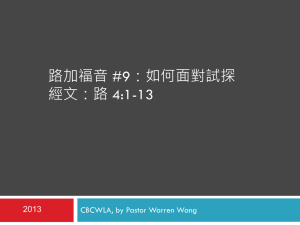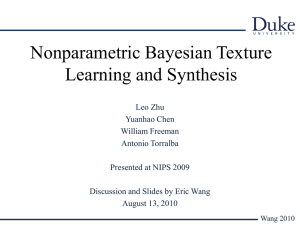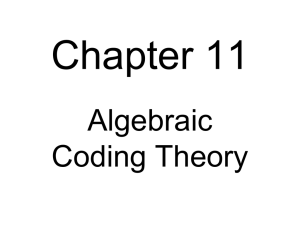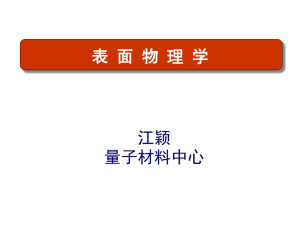Introduction to Reed
advertisement
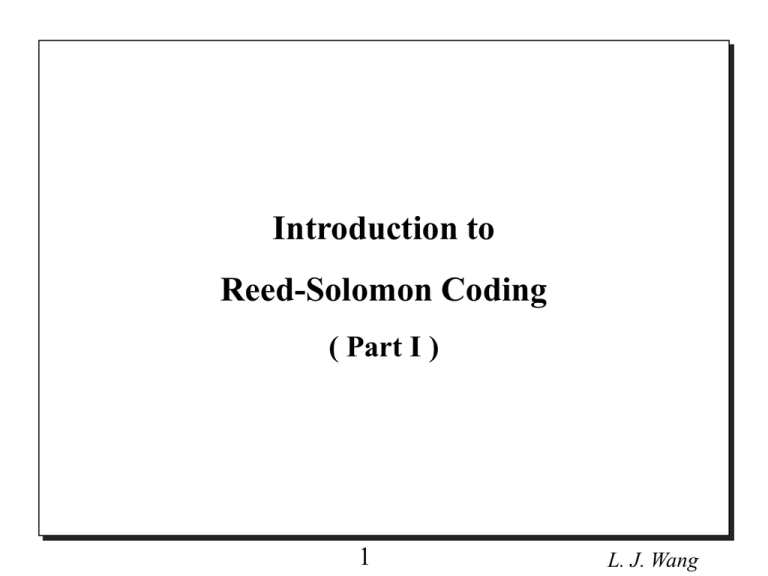
Introduction to Reed-Solomon Coding ( Part I ) 1 L. J. Wang Introduction One of the most error control codes is ReedSolomon codes. These codes were developed by Reed & Solomon in June, 1960. The paper I.S. Reed and Gus Solomon, “ Polynominal codes over certain finite fields ”, Journal of the society for industrial & applied mathematics. 2 L. J. Wang Reed-Solomon (RS) codes have many applications such as compact disc (CD, VCD, DVD), deep space exploration, HDTV, computer memory, and spread-spectrum systems. In the decades, since RS discovery, RS codes are the most frequency used digital error control codes in the world. 3 L. J. Wang Effect of Noise digital data 0 1 0 1 1 0 0 1 1 0 0 1 0 1 0 0 0 0 1 0 1 1 0 0 0 1 0 0 1 0 1 0 1 0 signal noise singal w ith noise sam pling tim e reconstruct -ed data bits in error F igure-1. E ffect of noise on a digital signal 4 L. J. Wang digital data 0 1 0 1 1 0 0 1 1 0 0 1 0 0 0 Reconstructed data 0 1 0 1 1 0 0 0 1 0 0 1 0 1 0 encoder 0 0 0 0 1 1 1 1 check bits, r=2 information bits, k=1 block length of code, n=3 000, 111 code word a ( n, k ) code, n=3, k=1, and r=n-k=3-1=2 code rate, p=k/n=1/3 encoder 000 111 000 111 111 000 000 receiver 000 101 000 111 111 010 001 decoder 000 111 000 111 111 000 000 5 L. J. Wang A (7,4) HAMMING CODE A (7,4) hamming code n=7, k=4, r=n-k=7-4=3, p=4/7. 0101 1100 1001 0000 I1 I2 I3 I4 encoder 0101c1 c2 c3 1100 c1 c2 c3 1001c1 c2 c3 receiver 0111c1c 2 c 3 1100 c1 c 2 c 3 1001c1 c 2 c 3 decoder 0101c1 c2 c3 1100 c1 c2 c3 1001c1 c2 c3 6 L. J. Wang Let a1, a2, ..., ak be the k binary of message digital. Let c1, c2, ..., cr be the r parity check bits. An n-digital codeword can be given by a1a2a3...akc1c2c3...cr n bits The check bits are chosen to satisfy the r=n-k equations, 0 = h11a1h12a2...h1kakc1 0 = h21a1h22a2...h2kakc2 . . (1) . 0 = hr1a1hr2a2...hrkakcr 7 L. J. Wang Equation (1) can be writen in matrix notation, h11 h12 ... h1k 1 0 ... 0 a1 0 h21 h22 ... h2k 0 1 ... 0 a2 0 . . . . ak . c1 0 . c2 0 . . 0 . hr1 hr2 ... hrk 0 0 ... 1 rn = cr 0 n1 r1 HT=0 8 L. J. Wang Let E be an n1 error pattern at least one error, that is E = e1 0 e2 . 0 . . . . en = ej . . = 1 0 Also let R be the received codeword, that is R = r1 a1 0 r2 . a2 . 0 . . = T + E = ak + ej . . c1 . . . rn cr 0 9 = 1 L. J. Wang Thus S = H R = H (T+E) = H T + H E = H E S=HE where S is an r1 syndorme pattern. Problem, for given S, Find E s1 h11 h12 0 s2 h21 h22 0 . = . e1 + . e2 + ... + . . . . . . . . . sr hr1 hr2 1 10 en (2) L. J. Wang Assume e1=0, e2=1, e3=0, ..., en=0 s1 h12 s2 h22 . = . . . . . sr hr2 The syndrome is equal to the second column of the parity check matrix H. Thus, the second position of received codeword is error. 11 L. J. Wang A (n,k) hamming code has n=r+k=2r-1, where k is message bits and r=n-k is parity check bits. The rate of the hamming code is given by R k n 2 1 r r 2 1 r 1 r 2 1 r Hamming code is a single error correcting code. In order to correct two or more errors, cyclic binary code, BCH code and Reed-Solomon code are developed to correct t errors, where t≧1. 12 L. J. Wang Single-error-correcting Binary BCH code In GF(24), let p(x)=x4+x+1 be a primitive irreducible polynomial over GF(24). Then the elements of GF(24) are 0 1 2 3 0 1 0011 5 2 0110 6 3 2 1100 7 3 1 1011 8 2 1 0101 9 3 1010 10 2 1 0111 11 3 2 1110 12 4 3 2 1111 13 1 3 2 1 1101 14 3 1 1001 15 1 4 = 0000 0001 0010 0100 1000 13 L. J. Wang The parity check matrix of a (n=15,k=11) BCH code for correcting one error is H ( 14 , 13 , 12 1 11 0 0 0 0 11 0 1 0 0 01 0 0 1 1 11 0 0 0 , ,..... , , , ) 11 3 2 1 0 0 0 0 1 Encoder: Let the codeword of this code is C 14 C 13 C 12 C 11 C 10 C 9 C 8 C 7 C 6 C 5 C 4 C 3 C 2 C 1 C 0 information bits parity check bits 14 L. J. Wang 1110010100 1c 3 c 2 c1 c 0 1 1 1 0 0 1 1 1 1 1 0 0 0 0 0 11 0 1 0 0 1 0 0 1 0 0 1 0 0 1 1 1 0 0 0 1 0 0 1 c3 c 2 c1 c 0 c0 1 1 1 0 0 1 1 1 c1 1 0 0 1 1 0 1 0 c2 1 1 0 0 0 0 0 c3 1 1 1 0 1 1 0 0 1 The code word is 1110010100 11001. 15 L. J. Wang Decoder: Let received word be R = C + codeword E error pattern H‧R=H(C+E)=H‧C+H‧ET=H‧ET 14 13 12 = e14 e13 e12 ..... e1 e 0 where E ( e14 , e13 , e12 , ...... , e1 , e 0 ) Let R=C+E=(11100101001001)+(00100....0) =(11000101001001) 16 L. J. Wang H *R T 1 1 0 1 1 1 0 1 1 0 0 0 0 0 0 1 1 1 14 13 11 1 0 0 0 0 H H H ( , , ,.... , ) 1 1 1 0 0 0 0 0 0 1 1 1 0 0 0 0 0 0 1 1 1 ( 0 0 1 12 ......... location 14 13 12 17 0 11 0 10 0 0 1 0 0 0 0 1 0 0 1 0 0 1 ...... 0 ) L. J. Wang Let Information polynomial be I(x)= C 14 x 14 C 13 x 13 C 12 x C6 x C5x C4x 6 5 12 C 11 x 11 C 10 x 10 C9 x C8 x C7 x 9 8 7 4 The codeword is C ( x ) C 14 x 14 C 13 x 13 ...... C 5 x C 4 x C 3 x C 2 x C 1 x C 0 5 Information polynomial 4 3 2 1 parity check polynomial R(x) I(x) 18 L. J. Wang Note that C(x)=Q(x)‧g(x) where g(x) is called a generator polynomial, C(x) is a codeword if and only if C(x) is a multiple of g(x). For example, to encode a (15,11) BCH code, the generator polynomial is g(x)=x4+x+1, where α is a order of 15 in GF(24) and is called a minimum polynomial of α. 19 L. J. Wang To encode, one needs to find C3,C2,C1,C0 or R(x) = C3 X C2 X 3 2 C1 X C 0 such that C ( x) I ( x) R ( x) satisfies C ( ) I ( ) R ( ) 0 To show this, dividing I(x) by g(x), one obtains I(x)=Q(x)g(x)+R(x) Encoder C(x)=I(x)+R(x)=Q(x)*g(x) C ( ) I ( ) R ( ) Q ( ) * g ( ) 0 Since C(x) is a multiple of g(x); then C(x)=I(x)+R(x) is a (15,11) BCH code. 20 L. J. Wang Example : I ( x) 1 x 14 1 x 1 x 13 0x 12 0x 11 0 x 1 x 0 x 0 x 1 x 8 7 6 5 Q (x) x g (x) x 4 x 1 x x 14 x 13 x 12 10 9 4 x x x 9 0x 14 1 x ... 10 8 11 0x 11 x … x 10 7 x x 5 2 x 1 .... 0 x 1 x 5 4 10 R( x) 1 x 0 x 0 x 1 3 2 I(x)=Q(x)g(x)+R(x) C(x)=Q(x)g(x)=I(x)+R(x) = x 14 x 13 x 12 0x 11 0x 10 1 x 0 x 1 x 0 x 9 8 7 6 0 x 1 x 1 x 0 x 0 x 1 5 4 3 2 =111001010011001 21 L. J. Wang To decode, let the error polynomial is E(x)= 0 x 14 0 x 13 1 x 12 0 x 11 0 x 10 .... 0 The received word polynomial is R’(x)=C(x)+E(x)= x 14 x 13 x 9 x 7 x 4 x 3 1 The syndrome is S R ( ) C ( ) E ( ) Q ( ) g ( ) E ( ) E ( ) = 14 = 3 13 1 3 12 1 2 9 2 7 1 4 3 3 1 3 1 1 3 1 3 12 is the error location in a received word. 22 L. J. Wang Double-error-correcting Binary BCH code To encode a (n=15, I=7) BCH code over GF(24), which can correct two errors. Let C(x)=K(x)g1(x)g2(x) where g1(α) is the minimal polynomial of α. => g1(α) = 0 g2(α3) is the minimal polynomial of α3. => g2(α3) = 0 23 L. J. Wang The minimal polynomial of αis g 1 ( x ) ( x )( x )( x 2 2 2 )( x 2 3 ) x x1 4 The minimal polynomial of α3 is g 2 ( x ) ( x )( x ( ) )( x ( ) )( x ( 3 3 2 3 4 3 8 ) ) x x x x1 4 3 2 The generator polynomial of a(15,7) BCH code is g ( x ) g 1 ( x ) g 2 ( x ) ( x x 1)( x x x x 1) 4 4 3 2 x x x x 1 8 7 6 4 24 L. J. Wang Reed-Solomon (RS) code An RS code is a cyclic symbol error-correcting code. An RS codeword will consist of I information or message symbols, together with P parity or check symbols. The word length is N=I+P. The symbols in an RS codeword are usually not binary, i.e., each symbol is represent by more than one bit. In fact, a favorite choice is to use 8-bit symbols. This is related to the fact that most computers have word length of 8 bits or multiples of 8 bits. 25 L. J. Wang In order to be able to correct ‘t’ symbol errors, the minimum distance of the code words ‘D’ is given by D=2t+1. If the minimum distance of an RS code is D, and the word length is N, then the number of message symbols I in a word is given by I=N–(D–1) P = D – 1. 26 L. J. Wang

